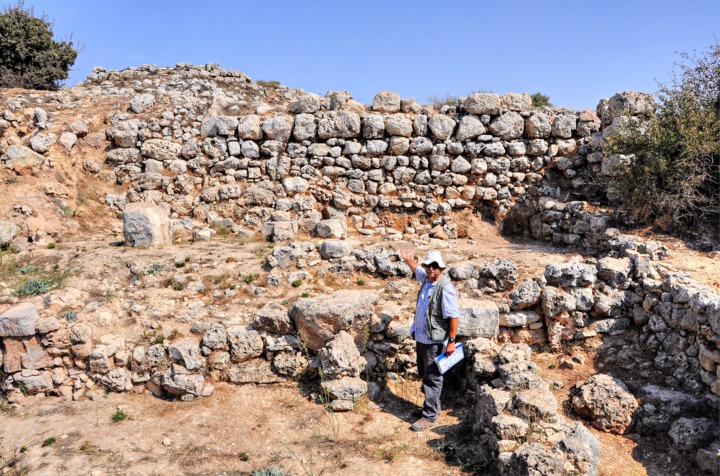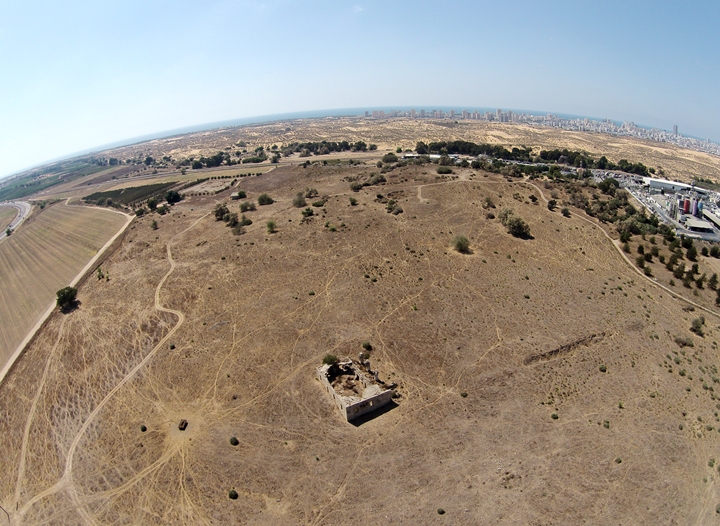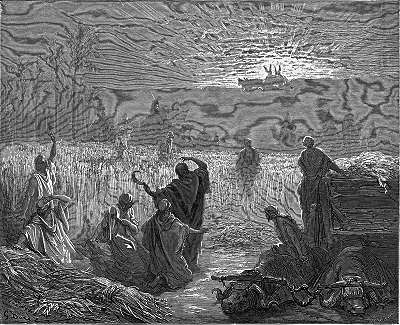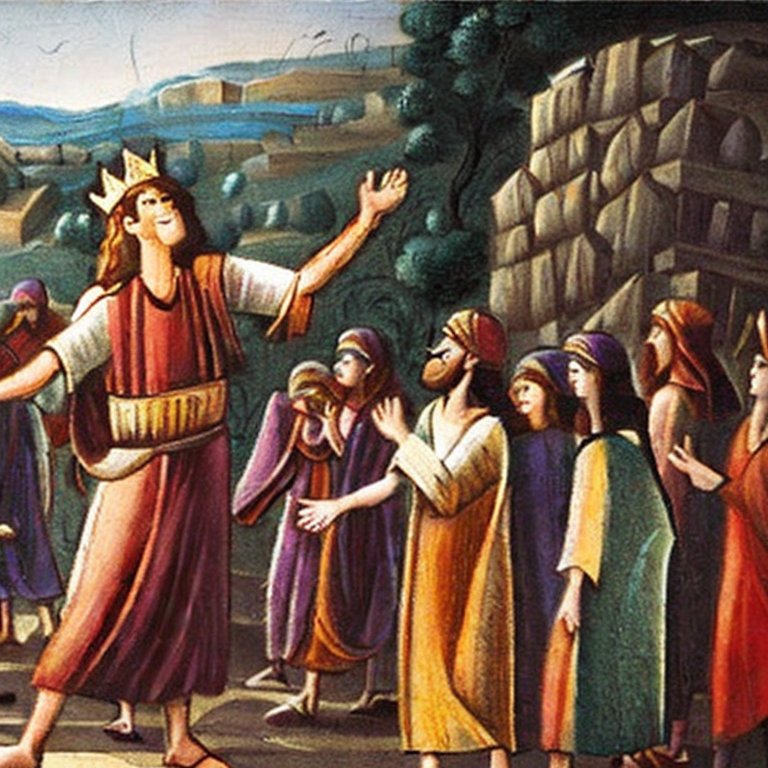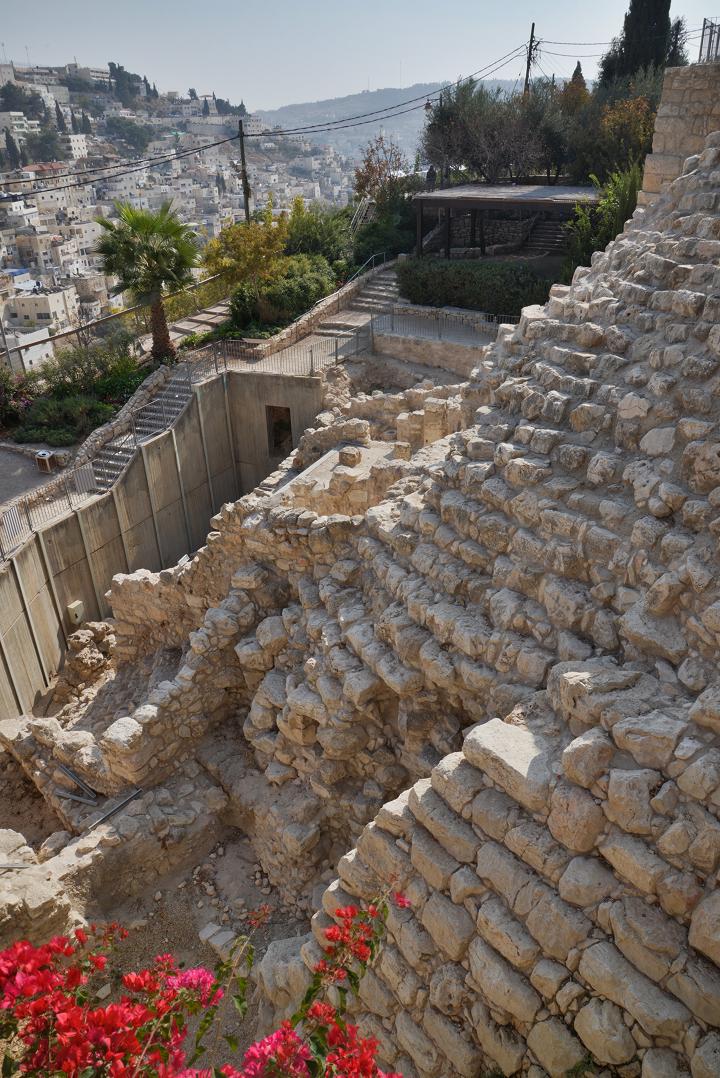This page describes the Ark of Covenant, and maps the stations of its journey to the actual sites.
Contents:
Overview
Sinai to Shiloh
Shiloh to Jerusalem
After Jerusalem
Overview
The Ark of the Covenant is a sacred object described in the Old Testament of the Bible as being a wooden chest covered with gold that contained the stone tablets inscribed with the Ten Commandments. According to the biblical account, the Ark was built at the command of God by the Israelites during their wanderings in the desert and was later placed in the Holy of Holies in the Temple of Jerusalem.
The Ark was seen as the symbol of God’s presence among the Israelites and was carried with them during their journeys. It was also associated with many miraculous events, such as the parting of the Red Sea and the collapse of the walls of Jericho.

Illustration of the ark in a desert tent
(Image created by AI using DALL·E through OpenAI’s ChatGPT)
The exact fate of the Ark is not known for certain, as it disappeared from history around the time of the Babylonian conquest of Jerusalem in 587 BC. Some theories suggest that it may have been hidden or destroyed, while others speculate that it was taken away to Ethiopia or another location.
The Ark continues to be an object of fascination and speculation, and its significance in the history and theology of Judaism and Christianity remains a subject of scholarly and religious study.
The stations of the ark:
(a) From Sinai to Shiloh
The Ark of Covenant is a gold-covered wooden chest with lid cover. It housed the two stone tablets of the Ten Commandments that Moses received from God on Mount Sinai (Exodus 24:18):
“And Moses went into the midst of the cloud, and gat him up into the mount: and Moses was in the mount forty days and forty nights”.
The ten commandments were inscribed on two stone tablets.
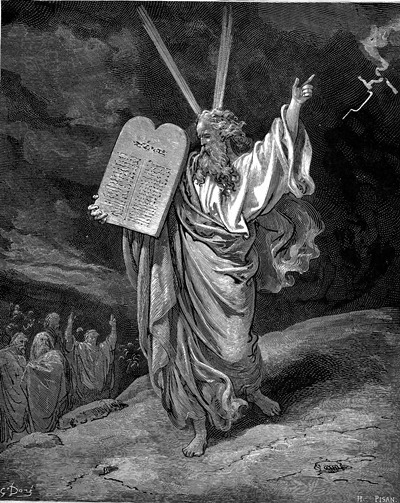
Moses comes down from Mt Sinai, holding tablets – drawing by Gustav Dore (French artist, 1832-1883)
Moses was instructed how to store the tablets in a hand carried ark. Its dimensions were approximately 131 cm ×79 cm × 79 cm (52×31×31 inches). The instructions were detailed (Exodus 25:10-16):
“And they shall make an ark of shittim wood: two cubits and a half shall be the length thereof, and a cubit and a half the breadth thereof, and a cubit and a half the height thereof. And thou shalt overlay it with pure gold, within and without shalt thou overlay it, and shalt make upon it a crown of gold round about. And thou shalt cast four rings of gold for it, and put them in the four corners thereof; and two rings shall be in the one side of it, and two rings in the other side of it. And thou shalt make staves of shittim wood, and overlay them with gold. And thou shalt put the staves into the rings by the sides of the ark, that the ark may be borne with them. The staves shall be in the rings of the ark: they shall not be taken from it. And thou shalt put into the ark the testimony which I shall give thee.”.
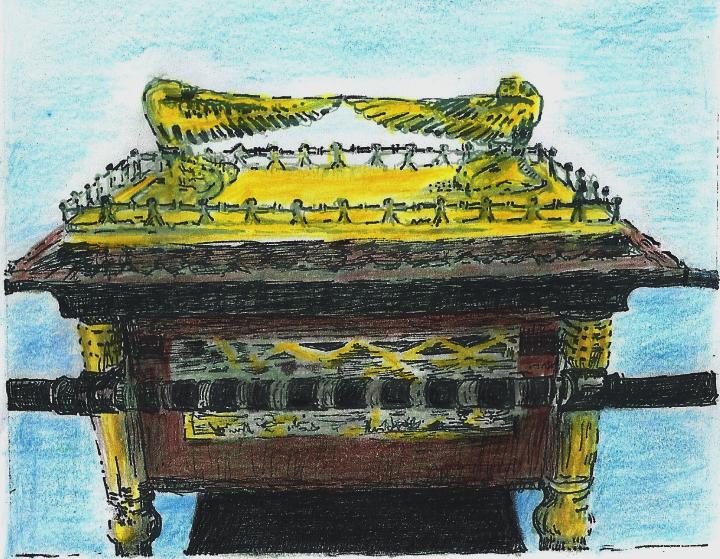 Ark of Covenant Drawing by grandma Rina
Ark of Covenant Drawing by grandma Rina
The ark is referred to in the Bible more than 200 times, and is considered an important ritual instrument.
The Israelites traveled for 40 years with the ark, which was carried by the Levites (Numbers 10:33):
“And they departed from the mount of the LORD three days’ journey: and the ark of the covenant of the LORD went before them in the three days’ journey, to search out a resting place for them”.
At every stop the ark was placed in a sacred tent – the Tabernacle (Exodus 41:21):
“And he brought the ark into the tabernacle, and set up the vail of the covering, and covered the ark of the testimony; as the LORD commanded Moses”.
After the death of Moses, Joshua led the Israelites to the Land of Israel (Joshua 3:17, 4:7):
“And the priests that bare the ark of the covenant of the LORD stood firm on dry ground in the midst of Jordan, and all the Israelites passed over on dry ground, until all the people were passed clean over Jordan… when it passed over Jordan, the waters of Jordan were cut off”.
The ark helped Joshua and the Israelites to capture the heavily fortified Jericho (Joshua 6:6):
“Take up the ark of the covenant, and let seven priests bear seven trumpets of rams’ horns before the ark of the LORD”.
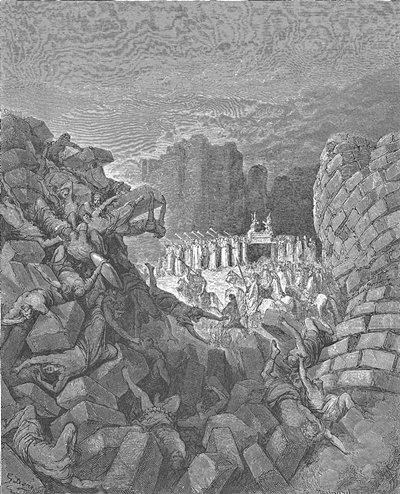
Ark of Covenant and the fall of Jericho – – drawing by Gustav Dore (French artist, 1832-1883)
(b) From Shiloh to Jerusalem
The Ark of Covenant traveled with the Israelites from Mount Sinai into the Land of Israel. It was then brought to a temple in Shiloh. The following are 8 stations of the ark since it came to its home in Shiloh and the events that followed after it was lost to the Philistines.
1: Shiloh
Shiloh was the religious capital of Israel during the times of the Judges, and spans 4,000 years of continuous settlement starting from the 18th century BC (Middle Bronze II). Shiloh was an assembly place for the people of Israel and a center of worship. Its sacred area (Tabernacle – Mishkan) in Shiloh housed the Ark of Covenant, Table of Showbread, Altar of Incense and Golden Lamp stand. (Joshua 18:1):
“And the whole congregation of the children of Israel assembled together at Shiloh, and set up the tabernacle of the congregation there”.
Shiloh was the home of the Tabernacle (Mishkan) for 369 years.
Where is Shiloh?
Tel Shiloh is located 17km south of Shechem, and is accessible from the city of Ariel. The ruins of Shiloh are part of the archaeological park of “Ancient Shiloh”, which is located in the entrance to the modern community of Shiloh.
Shiloh is sacred to three religions – Jewish, Christian and Muslim – and pilgrims come to visit the ruins for the past 3,060 years. On the south-east side of Tel Shiloh are ruins of Mosques and Churches and a modern Synagogue.
![]() Visit the site of Shiloh
Visit the site of Shiloh
2: Eben Haezer
The ark was lost to the Philistines following the battle of Eben ezer.
Description of the battle at Ebenezer, and the loss of the Ark (1 Samuel 4: 1-11):
“And the word of Samuel came to all Israel. Now Israel went out against the Philistines to battle, and pitched beside Ebenezer: and the Philistines pitched in Aphek. And the Philistines put themselves in array against Israel: and when they joined battle, Israel was smitten before the Philistines: and they slew of the army in the field about four thousand men. And when the people were come into the camp, the elders of Israel said, Wherefore hath the LORD smitten us to day before the Philistines? Let us fetch the ark of the covenant of the LORD out of Shiloh unto us, that, when it cometh among us, it may save us out of the hand of our enemies. So the people sent to Shiloh, that they might bring from thence the ark of the covenant of the LORD of hosts, which dwelleth between the cherubim: and the two sons of Eli, Hophni and Phinehas, were there with the ark of the covenant of God”.
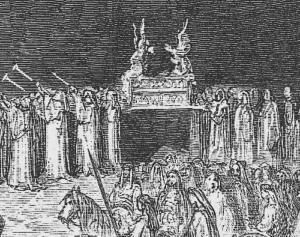
Ark of Covenant moved to the battlefield –
Part of a drawing by Gustav Dore (French artist, 1832-1883)
“And when the ark of the covenant of the LORD came into the camp, all Israel shouted with a great shout, so that the earth rang again. And when the Philistines heard the noise of the shout, they said, What meaneth the noise of this great shout in the camp of the Hebrews? And they understood that the ark of the LORD was come into the camp. And the Philistines were afraid, for they said, God is come into the camp. And they said, Woe unto us! for there hath not been such a thing heretofore. Woe unto us! who shall deliver us out of the hand of these mighty Gods? these are the Gods that smote the Egyptians with all the plagues in the wilderness. Be strong and quit yourselves like men, O ye Philistines, that ye be not servants unto the Hebrews, as they have been to you: quit yourselves like men, and fight. And the Philistines fought, and Israel was smitten, and they fled every man into his tent: and there was a very great slaughter; for there fell of Israel thirty thousand footmen. And the ark of God was taken; and the two sons of Eli, Hophni and Phinehas, were slain”.
The Philistines purged all the way to the heart of Samaria and destroyed Shiloh at some time after the defeat (Jeremiah 7 12):
“But go ye now unto my place which was in Shiloh, where I set my name at the first, and see what I did to it for the wickedness of my people Israel”
…and (Psalms 78 60):
“So that he forsook the tabernacle of Shiloh, the tent which he placed among men”.
- Where was Eben Ezer?
An Iron age agriculture settlement was excavated in Izbet Zartta, a small hill on the western hills of Samaria close to the ancient city of Aphek (Antipatris). It is identified as Ebenezer (“Stone of Help”), the place where the Israelites camped during their fatal battle with the Philistines.
![]() Visit the site of Izbet Zartta
Visit the site of Izbet Zartta
3: Ashdod
The Bible describes the course of the battle, and its tragic results: 34,000 Israelite soldiers dead, the two spiritual leaders (sons of Eli) were killed, and worse: the Ark of Covenant, which was brought from Shiloh to encourage the army, was taken by the Philistines (1 Samuel 5:1,2):
“And the Philistines took the ark of God, and brought it from Ebenezer unto Ashdod. When the Philistines took the ark of God, they brought it into the house of Dagon, and set it by Dagon”.
Dagon was one of the Philistine Gods, and worshiped in the city.
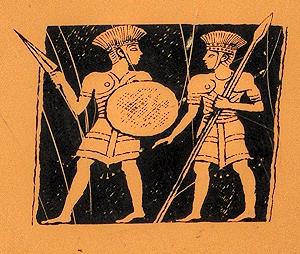
Philistine warriors – on sign of the Tel Zafit national park
The stolen ark did not stay too long in Ashdod, and was moved to Gath (1 Samuel 5:2-8):
“And when they of Ashdod arose early on the morrow, behold, Dagon was fallen upon his face to the earth before the ark of the LORD. And they took Dagon, and set him in his place again. And when they arose early on the morrow morning, behold, Dagon was fallen upon his face to the ground before the ark of the LORD; and the head of Dagon and both the palms of his hands were cut off upon the threshold; only the stump of Dagon was left to him. Therefore neither the priests of Dagon, nor any that come into Dagon’s house, tread on the threshold of Dagon in Ashdod unto this day. But the hand of the LORD was heavy upon them of Ashdod, and he destroyed them, and smote them with emerods, even Ashdod and the coasts thereof. And when the men of Ashdod saw that it was so, they said, The ark of the God of Israel shall not abide with us: for his hand is sore upon us, and upon Dagon our god. They sent therefore and gathered all the lords of the Philistines unto them, and said, What shall we do with the ark of the God of Israel? And they answered, Let the ark of the God of Israel be carried about unto Gath”.
Where was Biblical Ashdod?
The site of the Bronze and Iron Age periods is located on a the multi-period mound of Tel Ashdod , south and east of the modern city. It was first fortified in the 17th Century BC, and was one of the five large Philistine cities from the 12th Century to the 6th Century BC.
![]() Visit the site of Tel Ashdod
Visit the site of Tel Ashdod
4: Gath
After the Ark of Covenant was in Ashdod and caused damages to their temple, the Philistines moved it to Gath (1 Samuel 5:8):
“They sent therefore and gathered all the lords of the Philistines unto them, and said, What shall we do with the ark of the God of Israel? And they answered, Let the ark of the God of Israel be carried about unto Gath. And they carried the ark of the God of Israel about thither”.
Where is Gath?
Tel Zafit (Tell es-Safi) is one of the largest Biblical sites in Israel, located halfway between Ashkelon and Jerusalem. The Tel is in the western edge of the Judean foothills (Shephelah) area, bordering the southern coast plains. It is located on the south banks of the Elah stream.
The settlement on the tell started in the 5th millennium BC, reached its peak in the Late Bronze and Iron Age II periods, and was settled until modern times. It is widely accepted by scholars as the Philistine city of Gath – the hometown of Goliath.
![]() Visit the site of Tel Zafit.
Visit the site of Tel Zafit.
5: Ekron
While it was stationed in Gath, the Ark continued to bring destruction, so it was moved once again to Ekron (1 Samuel 5:9-10):
“And it was so, that, after they had carried it about, the hand of the LORD was against the city with a very great destruction: and he smote the men of the city, both small and great, and they had emerods in their secret parts. Therefore they sent the ark of God to Ekron…”.
Where is Ekron?
The city was positively identified with the large mound of Tel Miqne (Khirbet al Muqanna) as the Philistine Ekron. It is 18 kilometres north of Gath, east of Kibbutz Revadim. The site was occupied from the Middle Bronze period, when it was heavily fortified by large ramparts, through the Iron Age I when it was occupied by Philistines, until the Iron Age II when it was destroyed by the Babylonians (604 BC).
6: Beth Shemesh
Eventually the Philistines understood that the ark of the Covenant is dangerous to them, so they returned it back to the Israelites.
Its first station in the Israeli territory was in Beth Shemesh. They returned it by a cart. (1 Samuel 6 10,12):
“And see, if it goeth up by the way of his own coast to Bethshemesh, then he hath done us this great evil: but if not, then we shall know that it is not his hand that smote us: it was a chance that happened to us. And the men did so; and took two milch kine, and tied them to the cart, and shut up their calves at home: And they laid the ark of the LORD upon the cart, and the coffer with the mice of gold and the images of their emerods.
And the kine took the straight way to the way of Bethshemesh, and went along the highway, lowing as they went, and turned not aside to the right hand or to the left; and the lords of the Philistines went after them unto the border of Bethshemesh. And they of Bethshemesh were reaping their wheat harvest in the valley: and they lifted up their eyes, and saw the ark, and rejoiced to see it. And the cart came into the field of Joshua, a Bethshemite, and stood there, where there was a great stone: and they clave the wood of the cart, and offered the kine a burnt offering unto the LORD. And the Levites took down the ark of the LORD, and the coffer that was with it, wherein the jewels of gold were, and put them on the great stone: and the men of Bethshemesh offered burnt offerings and sacrificed sacrifices the same day unto the LORD. And when the five lords of the Philistines had seen it, they returned to Ekron the same day.
Return of the Ark – at Beth Shemesh; drawing by Gustav Dore (French artist, 1832-1883)
The residents of Beth Shemesh peeked into the Ark, God killed them, and the Ark was sent to the nearby city of Kiryat Ye’arim:
“And he smote the men of Bethshemesh, because they had looked into the ark of the LORD, even he smote of the people fifty thousand and threescore and ten men: and the people lamented, because the LORD had smitten many of the people with a great slaughter. And the men of Bethshemesh said, Who is able to stand before this holy LORD God? and to whom shall he go up from us? And they sent messengers to the inhabitants of Kirjathjearim, saying, The Philistines have brought again the ark of the LORD; come ye down, and fetch it up to you”.
Where is Beth Shemesh?
Beth Shemesh (“House of the Sun”) was an important Biblical city during the Canaanite and Israelite periods. It is located above the south bank of Nahal Sorek, in the north-east low lands of Judea. It was a border city, located at the meeting point of three civilizations – Canaanites, Israelites and Philistines.
![]() Visit the site of Tel Beth Shemesh
Visit the site of Tel Beth Shemesh
7: Kiriath Jearim
The ark was then brought to Kiriath Jearmin, to the house of Abinadab (1 Samuel 7: 1-2):
“And the men of Kirjathjearim came, and fetched up the ark of the LORD, and brought it into the house of Abinadab in the hill, and sanctified Eleazar his son to keep the ark of the LORD. And it came to pass, while the ark abode in Kirjathjearim, that the time was long; for it was twenty years: and all the house of Israel lamented after the LORD”.
Where is Kiriath Jearim?
Ruins of the Israelite city of Kiriath Jearim are located on a hill on the north western side of Abu Ghosh. Kiriath Jearim (Hebrew: Kir’yat Ye’arim – Town of Forests”) is the place where the ark of Covenant was stationed after the Philistines returned it to the Israelites. Later, King David moved it to the city of David.
On top of the mound of Tel Kir’yat Ye’arim is the Abbey of the ark of Covenant, built on the foundations of a Byzantine church.
![]() Visit the site of Kiriath Jearim
Visit the site of Kiriath Jearim
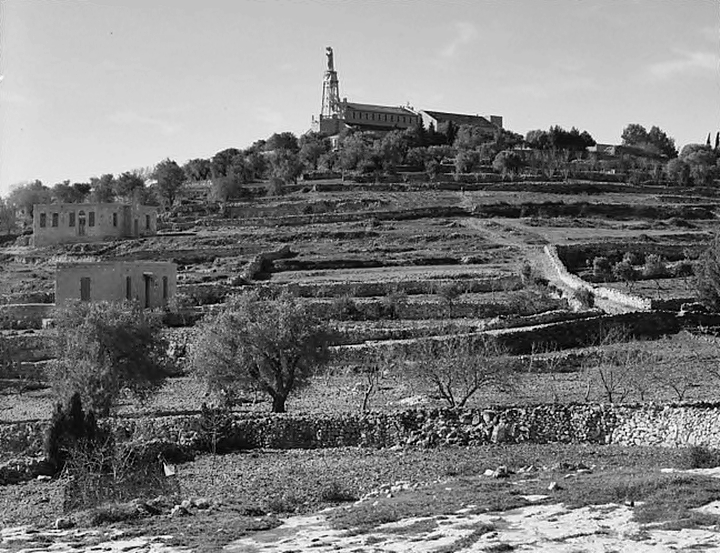
8: Jerusalem
After about 60 years, when David became king, he brought the ark to Jerusalem (2 Samuel 6):
“Again, David gathered together all the chosen men of Israel, thirty thousand. And David arose, and went with all the people that were with him from Baale of Judah, to bring up from thence the ark of God, whose name is called by the name of the LORD of hosts that dwelleth between the cherubims. And they set the ark of God upon a new cart, and brought it out of the house of Abinadab that was in Gibeah: and Uzzah and Ahio, the sons of Abinadab, drave the new cart. And they brought it out of the house of Abinadab which was at Gibeah, accompanying the ark of God: and Ahio went before the ark. And David and all the house of Israel played before the LORD on all manner of instruments made of fir wood, even on harps, and on psalteries, and on timbrels, and on cornets, and on cymbals”.
King David parades the ark to Jerusalem– AI generated by Stable Diffusion
The ark was temporarily stationed at the house of Obededom the Gittite for 3 months, then brought into the City of David in Jerusalem with a parade led by David (2 Samuel 6: 14-16):
“And David danced before the LORD with all his might; and David was girded with a linen ephod. So David and all the house of Israel brought up the ark of the LORD with shouting, and with the sound of the trumpet.And as the ark of the LORD came into the city of David…”.
![]() Visit the site of City of David
Visit the site of City of David
(c) After Jerusalem
The Babylonians captured the city of Jerusalem in 587 BC. The Ark vanished after this conquest.
The ark of covenant – from the synagogue at Capernaum.
The fate of the Ark of the Covenant after the Babylonian conquest of Jerusalem is not definitively known. According to the Bible, the Ark was housed in the First Temple in Jerusalem, which was destroyed by the Babylonians. The Book of 2 Kings describes the Babylonians plundering the Temple and carrying away its treasures, but it does not mention the Ark specifically.
Various theories exist about what may have happened to the Ark after the destruction of the Temple. Some scholars believe that the Ark was captured and taken to Babylon as part of the spoils of war, while others speculate that it may have been hidden or moved elsewhere before the Babylonians arrived. There are also legends and stories that suggest that the Ark was smuggled out of Jerusalem and taken to Ethiopia or even to a secret location in the desert.
However, there is no concrete evidence to support any of these theories, and the true fate of the Ark of the Covenant remains a mystery.
BibleWalks.com – walk with us through the sites of the Holy Land
Biblical articles<<<—Previous Info—<<< All Info >>>—Next Info—>>> Timeline
This page was last updated on Feb 20, 2025 (replace illustration)
Sponsored links:
